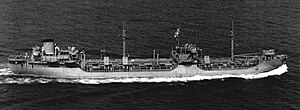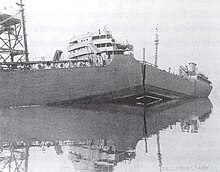
Liberty ships were a class of cargo ship built in the United States during World War II under the Emergency Shipbuilding Program. Although British in concept, the design was adopted by the United States for its simple, low-cost construction. Mass-produced on an unprecedented scale, the Liberty ship came to symbolize U.S. wartime industrial output.

Marinship Corporation was a shipbuilding company of the United States during World War II, created to build the shipping required for the war effort. Founded in 1942, the shipyard built 93 cargo ships and oil tankers, before ending operations in 1945.
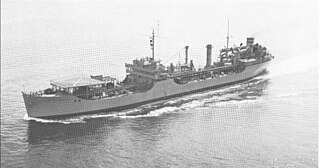
SS Mission Capistrano was a Type T2-SE-A2 tanker built for the United States Maritime Commission during World War II. After the war she was acquired by the United States Navy as USS Mission Capistrano (AO-112). Later the tanker transferred to the Military Sea Transportation Service as USNS Mission Capistrano (T-AO-112). She was a Mission Buenaventura-class oiler and was named for San Juan Capistrano in San Juan Capistrano, California.
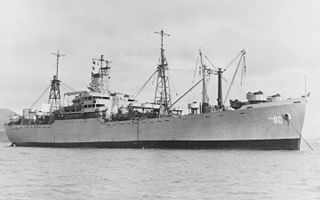
Type C2 ships were designed by the United States Maritime Commission (MARCOM) in 1937–38. They were all-purpose cargo ships with five holds, and U.S. shipyards built 328 of them from 1939 to 1945. Compared to ships built before 1939, the C2s were remarkable for their speed and fuel economy. Their design speed was 15.5 knots (28.7 km/h), but some could make 19 knots (35 km/h) on occasion. The first C2s were 459 feet (140 m) long, 63 feet (19 m) broad, and 40 feet (12 m) deep, with a 25-foot (8 m) draft. Later ships varied somewhat in size. Some, intended for specific trade routes, were built with significant modifications in length and capacity.
USS Cache (AO-67) was a Type T2-SE-A1 Suamico-class fleet oiler of the United States Navy.

USNS Paoli (T-AO-157) was a Gettysburg-class fuel tanker, built at Sun Shipbuilding & Drydock Co. in Chester, Pennsylvania. A Type T2–SE–A1 tanker, it was hull number 401 and Maritime Commission number 1734. The ship was laid down on 18 July 1944, launched on 31 October 1944, sponsored by Mrs. Lina Martin, and delivered to the Maritime Commission on 11 November 1944 for operation by War Emergency Tankers, New York City.
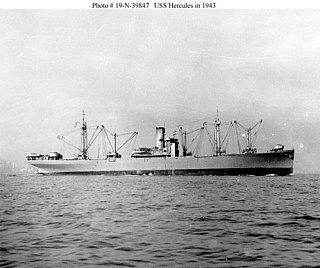
Type C3-class ships were the third type of cargo ship designed by the United States Maritime Commission (MARCOM) in the late 1930s. As it had done with the Type C1 ships and Type C2 ships, MARCOM circulated preliminary plans for comment. The design presented was not specific to any service or trade route, but was a general purpose ship that could be modified for specific uses. A total of 162 C3 ships were built from 1939 to 1946.
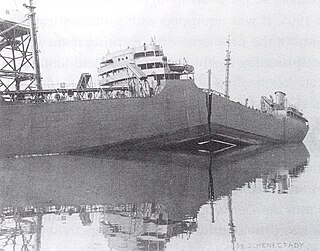
The SS Schenectady was a T2-SE-A1 tanker built during World War II for the United States Maritime Commission.
SS Conastoga may refer to one of three Type T2 tankers built for the United States Maritime Commission during World War II:
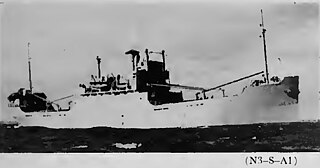
Type N3-S ships were a Maritime Commission small coastal cargo ship design to meet urgent World War II shipping needs, with the first of the 109 N3, both steam and diesel, type hulls delivered in December 1942.

The Suamico class were a class of 25 United States Navy oilers during World War II. Built to the Maritime Commission T2-SE-A1, -A2 and -A3 (Cohocton) designs, they used turbo-electric transmission, obviating the need for reduction gearing which was a major issue in US mass-production shipbuilding.

The T3 tanker, or T3, are a class of seaworthy large tanker ships produced in the United States and used to transport fuel oil, gasoline or diesel before and during World War II, the Korean War and the Vietnam War. The T3 tanker classification is still used today. The T3 tanker has a full load displacement of about 24,830 tons.
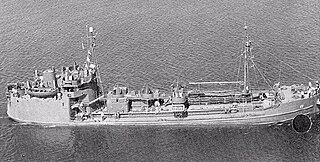
The T1 tanker or T1 are a class of sea worthy small tanker ships used to transport fuel oil before and during World War II, Korean War and Vietnam War. The T1 tanker classification is still in use today. T1 tankers are about 200 to 250 feet in length and are able to sustain a top speed of about 12 knots. The hull designation AO is used by the US Navy to denote the ship is a T1 oil tanker and AOG that the T1 is a gasoline tanker. The small size allows the T1 to enter just about any sea port or to anchor around a small island, this was very useful during the Pacific War. The T1 tanker can carry about 48,000 to 280,000 bbls. Some T1 tankers were used to transport goods other than oil, a few were used for black oil-crude oil, diesel, chemicals and rarely bulk cargo like grain. T1 tankers are also called liquid cargo carriers. The T1 tanker has about a 6,000 to 35,000 deadweight tonnage (DWT) of cargo. The small size also gives the ships short turn around time for repair, cleaning, loading and unloading. A T1 tanker carrying dirty cargo, like crude oil needs a few weeks of labor to clean before carrying clean cargo. Most T1 ships during World War II were named after major oil fields.

The McDougall Duluth Shipbuilding Company was a large-scale wartime ship manufacturing shipyard, located at the city of Riverside, near Duluth. McDougall Duluth Shipbuilding was at 110 Spring Street, Duluth, Minnesota, now the site of the West Duluth's Spirit Lake Marina. The shipyard was located on St. Louis River Estuary at western part of Lake Superior. McDougall Duluth Shipbuilding Company was founded by Alexander McDougall (1845-1923) in 1917 to build ships for World War I. McDougall Duluth Shipbuilding Company and the Superior Shipbuilding Company were called the Twin Ports shipbuilding industry of Minnesota and Wisconsin. Once built the ships can travel to the Atlantic Ocean through the Great Lakes and the Saint Lawrence Seaway.
Sword Line Inc. was a steamship company founded by Charilaos "Charles" G. Poulacos and Abbott Abercrombie in New York City in 1933. Sword Line Inc. had shipping routes from Atlantic ports to and Gulf of Mexico ports. Charilaos "Charles" G. Poulacos and Abbott Abercrombie purchased the ship Eastern Sword in 1932. The Eastern Sword was a 3,785-ton cargo ship built in 1920 at the Uraga Dry Dock Co. Ltd, at Uraga, Japan. The ship sank after being hit by a torpedo from German submarine U-162 on May 4, 1942 twelve miles (19 km) off the coast of Georgetown, Guyana. The Eastern Sword had a crew of 38 and only 13 survived the attack. Sword Line Inc. was active in supporting the World War II effort.

American Petroleum Transport Corporation was an oil shipping company founded in New York City in 1936. Daniel K. Ludwig was President of American Petroleum Transport Corporation. In 1939 American Petroleum Transport Corporation operated eight tanker ships from the Gulf of Mexico to Hatteras, North Carolina. American Petroleum Transport Corporation was active in supporting the World War II efforts. Some tanker ships American Petroleum Transport Corporation operated were sunk by German U-boat submarines. Daniel K. Ludwig founded in 1936 the company National Bulk Carriers.

Bernuth-Lembcke Company was a tanker ship transportation company founded in 1918 in New York City by Oscar Max von Bernuth and Carlos Eduardo Lembcke. Earlier Oscar Max von Bernuth founded his own company, Bernuth Corporation, on December 20, 1907, in at Suffolk, New York. Carlos Eduardo Lembcke. Earlier founded his own company, C. Lembeke & Company, in 1889. Bernuth-Lembcke Company were active in supporting the World War II effort, shipping fuel oil.

Sieling & Jarvis Inc. was a shipping company that operated tanker ships and some cargo ships. Sieling & Jarvis was started by David B. Jarvis and Dick Sieling in New York City. Later David B. Jarvis was the company president and later became the sole owner of Sieling & Jarvis Inc. Mr. Sieling was the vice president and a partner in Sieling & Jarvis. Sieling & Jarvis supported the World War II effort by operating United States owned ships.
